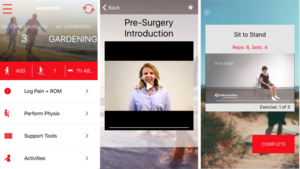Activate TKR: Mobile support for total knee replacement
Bringing vital healthcare information to patients’ fingertips, Activate TKR supports patients in their pre-surgery preparation and rehabilitation programs.
The challenge
Total knee replacement (TKR) procedures in Australia have risen by 77 per cent between 2003 and 2014 alone.
Studies show rehabilitation exercises following surgery can lead to faster recovery times. However, many patients fail to implement effective preparation or rehabilitation plans.
Our response
We developed Activate TKR, which provides patients with practical information via a mobile app. The platform contains physiotherapy demonstration videos, checklists, reminders and supportive information in text, video and audio formats.

Images of the different pages within the Activate TKR app
The TKR App, supporting patients from pre-surgery to post surgery
The technology includes a wearable activity tracker to encourage exercise, track steps and support self-monitoring of progress.
Clinical care teams monitor patients and configure physiotherapy programs via a clinical portal.
The results
A multi-site multi-state randomised control trial was implemented at four hospitals in Australia with 133 patients. The technology was provided to intervention patients before and after surgery in addition to regular care.
Physiotherapists reported the greatest enhancements in care delivery due to access to patient-generated information. The data facilitated appointment preparation, progress discussion and tailoring of physiotherapy.
Surgeons placed most value on the information provided to patients about their surgical journey. They noted that patients with access to the app had an enhanced TKR experience.
Intervention patients reported being more responsible and accountable for their rehabilitation, enabled through reminders and the ability to monitor their progress.
Benefits came with increased patient expectations. Providing alternative communication points between patient and care teams shifted patient expectations about real-time monitoring and service availability.
The Australian e-Health Research Centre (AEHRC) is CSIRO's digital health research program and a joint venture between CSIRO and the Queensland Government. The AEHRC works with state and federal health agencies, clinical research groups and health businesses around Australia.
